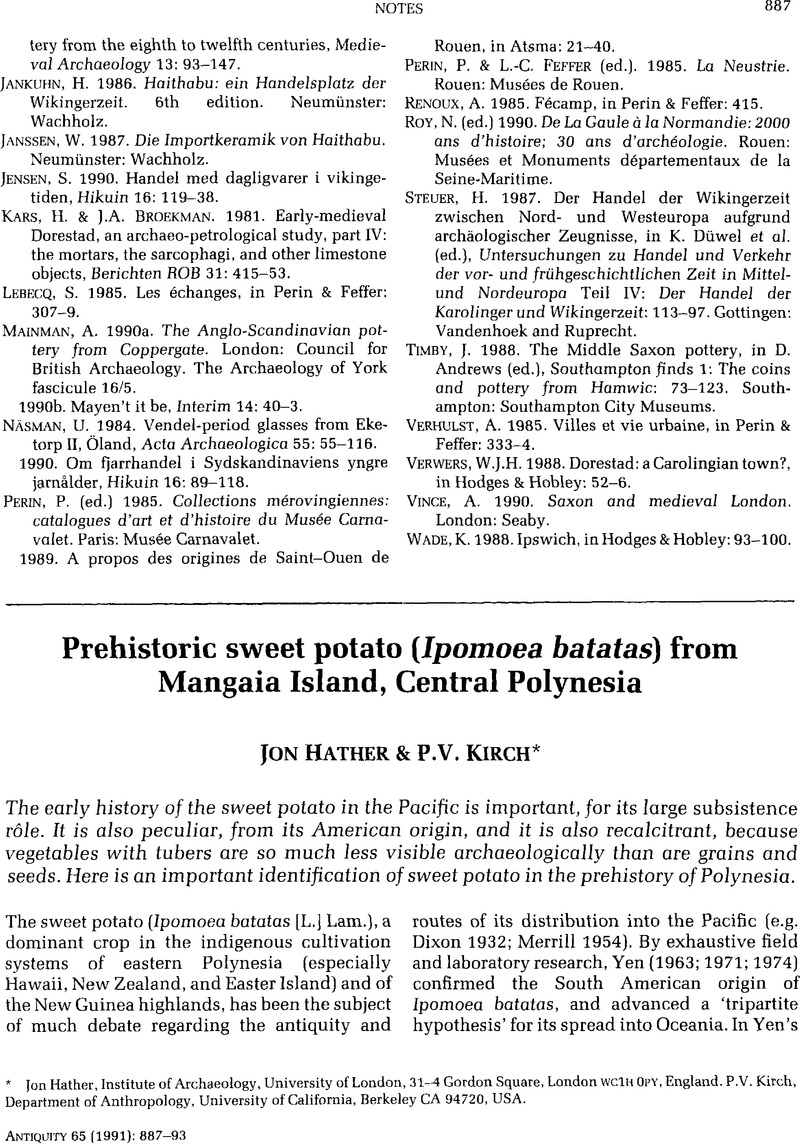Crossref Citations
This article has been cited by the following publications. This list is generated based on data provided by Crossref.
Hather, Jon G.
1992.
The archaeobotany of subsistence in the Pacific.
World Archaeology,
Vol. 24,
Issue. 1,
p.
70.
Kirch, Patrick V.
and
Ellison, Joanna
1994.
Palaeoenvironmental evidence for human colonization of remote Oceanic islands.
Antiquity,
Vol. 68,
Issue. 259,
p.
310.
Hather, Jon G.
and
Hammond, Norman
1994.
Ancient Maya subsistence diversity: root and tuber remains from Cuello, Belize.
Antiquity,
Vol. 68,
Issue. 259,
p.
330.
Kirch, P. V.
and
Weisler, M. I.
1994.
Archaeology in the Pacific Islands: An appraisal of recent research.
Journal of Archaeological Research,
Vol. 2,
Issue. 4,
p.
285.
Araújo, Adauto
and
Ferreira, Luiz F.
1995.
Oxiuríase e migrações pré-históricas.
História, Ciências, Saúde-Manguinhos,
Vol. 2,
Issue. 1,
p.
99.
Langdon, Robert
1995.
New light on Easter Island prehistory in a ‘censored’ Spanish report of 1770.
The Journal of Pacific History,
Vol. 30,
Issue. 1,
p.
112.
Holden, T.G.
Hather, J.G.
and
Watson, J.P.N.
1995.
Mesolithic plant exploitation at the Roc del Migdia, Catalonia.
Journal of Archaeological Science,
Vol. 22,
Issue. 6,
p.
769.
Kirch, Patrick V.
Steadman, David W.
Butler, Virginia L.
Hather, Jon
and
Weisler, Marshall I.
1995.
Prehistory and human ecology in Eastern Polynesia: Excavations at Tangatatau Rockshelter, Mangaia, Cook Islands.
Archaeology in Oceania,
Vol. 30,
Issue. 2,
p.
47.
Maloney, Bernard K.
1998.
Human Activities and the Tropical Rainforest.
Vol. 44,
Issue. ,
p.
65.
Harris, David R.
1999.
Dolores R. Piperno & Deborah M Pearsall. The origins of agriculture in the lowland Neotropics.
xiv+400 pages, 14 colour plates, numerous illustrations. 1998. London & New York (NY): Academic Press; 0-12-557180-1 hardback $99.
Antiquity,
Vol. 73,
Issue. 279,
p.
242.
Underwood, Grant
2000.
Mormonism, the Maori and Cultural Authenticity.
The Journal of Pacific History,
Vol. 35,
Issue. 2,
p.
133.
2000.
The Cambridge World History of Food.
p.
73.
O'Brien, Patricia J.
2000.
The Cambridge World History of Food.
p.
207.
Langdon, Robert
2001.
The bamboo raft as a key to the introduction of the sweet potato in prehistoric Polynesia.
The Journal of Pacific History,
Vol. 36,
Issue. 1,
p.
51.
Kuhlken, Robert
2002.
Intensive Agricultural Landscapes of Oceania.
Journal of Cultural Geography,
Vol. 19,
Issue. 2,
p.
161.
Gamble, Lynn H.
2002.
Archaeological Evidence for the Origin of the Plank Canoe in North America.
American Antiquity,
Vol. 67,
Issue. 2,
p.
301.
Campbell, Matthew
2003.
Productivity, production and settlement in precontact Rarotonga, Cook Islands.
Archaeology in Oceania,
Vol. 38,
Issue. 1,
p.
9.
Hurles, Matthew E.
Matisoo-Smith, Elizabeth
Gray, Russell D.
and
Penny, David
2003.
Untangling Oceanic settlement: the edge of the knowable.
Trends in Ecology & Evolution,
Vol. 18,
Issue. 10,
p.
531.
Jones, Terry L.
and
Klar, Kathryn A.
2005.
Diffusionism Reconsidered: Linguistic and Archaeological Evidence for Prehistoric Polynesian Contact with Southern California.
American Antiquity,
Vol. 70,
Issue. 3,
p.
457.
Harris, David R.
2006.
The interplay of ethnographic and archaeological knowledge in the study of past human subsistence in the tropics.
Journal of the Royal Anthropological Institute,
Vol. 12,
Issue. s1,





